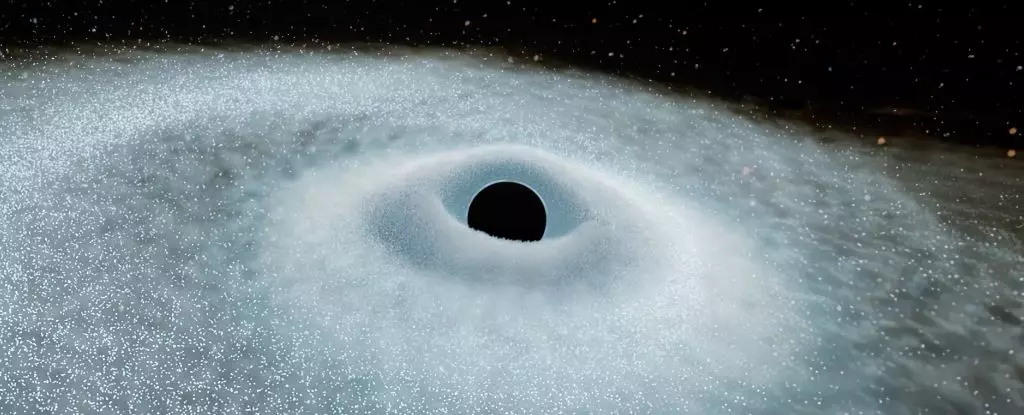In the expansive realms of the universe, significant happenings often remain hidden for eons. However, recent observations from the Gaia space telescope have shed light on an unprecedented phenomenon in the field of astrophysics—extreme nuclear transients (ENTs). These extraordinary cosmic events mark not just a revelation in understanding black holes but a dramatic shift in how we conceive the dynamic interplay of celestial bodies. With bursts of luminosity that exceed even the most stellar supernova explosions, ENTs offer a new perspective on the life cycles of stars and their ultimate fate at the hands of supermassive black holes.
Beyond Expectations: The Energetic Scale of ENTs
The energy emitted during these extreme nuclear transients is staggering. While conventional tidal disruption events (TDEs)—the demise of stars as they are drawn toward black holes—release energy comparable to that of a single star over its entire lifespan, ENTs ramp up the stakes significantly. Research indicates that these phenomena can produce energy equivalent to that of 100 Suns collectively. This enormous output calls into question the existing models of stellar death and black hole interaction, showing us that the universe still harbors secrets we have yet to uncover.
Astrophysicist Jason Hinkle of the University of Hawai’i illustrates the importance of ENTs by noting their unprecedented brightness levels, which are nearly ten times more intense than standard TDEs. The prolonged durations of these events, lasting years instead of days or months, create an entirely new challenge for astronomers: understanding the mechanics behind these dazzling displays and their implications for black hole growth.
The Mechanism Behind Tidal Disruption Events
At the heart of the carnage associated with black holes lies the concept of tidal forces. When a star strays too close, the gravitational pull from the black hole can exceed the star’s own gravitational integrity. This results in a dramatic fraying of the stellar material, releasing a cacophony of light and energy—a phenomenon that astrophysicists have been observing and cataloging for over a decade. TDEs typically follow a predictable pattern: a sudden brightening, a sharp peak in luminosity, and a gradual decline. However, ENTs challenge this predictability, suggesting that there exist subtypes and variations of these cosmic events warranting deeper investigation.
The discovery of ENTs raises the tantalizing possibility that we may be observing a new type of cosmic explosion. With the Gaia telescope’s oversight, scientists can now capture events that, while rare, offer incredible insights into the more ferocious aspects of black holes and their galactic ecosystems.
The Gaia Space Telescope: A Serendipitous Observer
Originally launched to map the Milky Way, the Gaia space telescope has accomplished much more than anticipated. While its primary mission focused on measuring stellar distances, its attentive monitoring capabilities allowed for the detection of Gaia16aaw and Gaia18cdj—two pivotal ENTs that share characteristics with the earlier spectacular event dubbed “Scary Barbie.” This highlights the serendipitous nature of scientific exploration, where tools designed for specific purposes can yield unexpected discoveries, reshaping our understanding of the universe.
Astrophysics is often a race against time, and the rarity of ENTs—estimated to occur 10 million times less frequently than supernovae—makes their capture invaluable. Each detection is a window into a moment in time, unraveling cosmic history in ways we have yet to fully grasp.
A Paradigm Shift in Black Hole Research
These newly identified extreme nuclear transients represent more than just another facet of cosmic phenomena; they symbolize a crucial missing piece in understanding black hole growth. As supermassive black holes are increasingly recognized for their gravitational influence on the structure and evolution of galaxies, ENTs provide an exceptional avenue for studying how these massive entities accrue mass over time.
Benjamin Shappee, another astrophysicist from the University of Hawai’i, emphasizes the significance of ENTs as a tool for astronomical inquiry. Their brightness enables observations at vast cosmic distances, effectively allowing scientists to look back in time and study galactic evolutionary processes. This ability to peek into the distances, where light from these events takes millions of years to reach us, is not merely an impressive capability; it is essential for piecing together the history of our universe.
The emergence of extreme nuclear transients serves as a reminder that even in the well-trodden fields of astronomy and astrophysics, the cosmos still holds mysteries waiting to be unveiled. As researchers delve deeper into the nature of ENTs, we edge closer to not only unraveling the complexities surrounding black holes but also extending our grasp of the celestial dynamics that govern our universe. Each newfound discovery leads us to rethink the boundaries of possibility, encouraging both curiosity and wonder in the face of the unknown.

